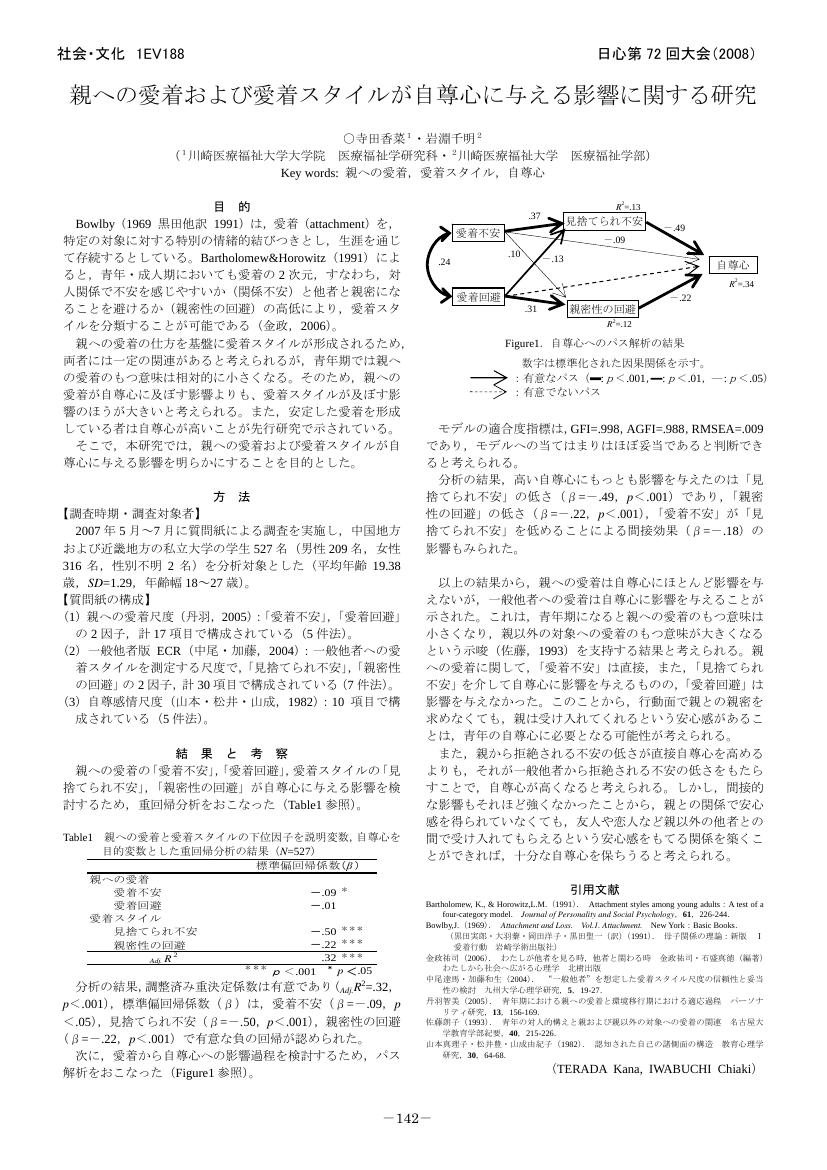3 0 0 0 OA 親への愛着および愛着スタイルが自尊心に与える影響に関する研究
- 著者
- 寺田 香菜 岩淵 千明
- 出版者
- 公益社団法人 日本心理学会
- 雑誌
- 日本心理学会大会発表論文集 日本心理学会第72回大会 (ISSN:24337609)
- 巻号頁・発行日
- pp.1EV188, 2008-09-19 (Released:2018-09-29)
1 0 0 0 OA ケプストラムおよびスペクトル分析による音声障害指標の日本語話声への適用について
- 著者
- 土師 知行 寺田 香菜子
- 出版者
- 日本喉頭科学会
- 雑誌
- 喉頭 (ISSN:09156127)
- 巻号頁・発行日
- vol.32, no.02, pp.195-206, 2020-12-01 (Released:2021-05-11)
- 参考文献数
- 19
The validity of the application of the Cepstral/Spectral Index of Dysphonia (CSID) to Japanese dysphonic speech was examined by analyzing normal and breathy voice samples both produced by healthy Japanese volunteers with no vocal problems. Four Japanese sentences which had phonological similarities to the English test sentences were prepared for the application of the CSID. The voice samples included sustained vowel /a/ and the four sentences.The CSID was applied for analyzing both the sustained vowel and the four sentences. Established indices based on pitch synchronous analyses, such as period perturbation quotient (PPQ), amplitude perturbation quotient (APQ) and noise to harmonic ratio (NHR) were applied to the samples of the sustained vowel.For the grade of the hoarseness and the breathiness, auditory perceptual evaluations of Japanese speech sentences and the sustained vowel were performed using a visual analog scale (VAS). GRBAS scale was used for evaluations of the sustained vowel only.Strong statistical relationships were found between the CSID and the three indices with pitch synchronous analyses. Furthermore, the CSID had strong statistical relationships with the two auditory perceptual evaluations as well, which was equal to relationships between the auditory perceptual evaluations and the indices with pitch synchronous analyses. Given that the CSID can be used to analyze speech samples whereas the indices with pitch synchronous analysis have certain technical problems to analyze speech samples, this index is considered to be applicable as a useful measure for evaluating vocal dysfunction of Japanese speech and should be used actively in clinical settings.
- 著者
- 飯田 昭人 寺田 香 黒澤 直子 斉藤 美香
- 出版者
- 北翔大学
- 雑誌
- 北翔大学北方圏学術情報センター年報 (ISSN:21853096)
- 巻号頁・発行日
- vol.2, pp.1-12, 2009
本研究では,臨床心理士や社会福祉士,臨床発達心理士,教師の資格を有し,総合病院や発達障害児者対象の相談機関,児童養護施設,特別支援学校で働いている5名の対人援助職者を対象に,クライエントの「家族」をどう考えているのか,家族と接する上でどのようなことに配慮しているのかといった,家族の視点について,主に質的分析により明らかにすることを目的とした。クライエントの家族に対する対人援助職者の視点として,以下の5点が見出された。①家族への情報等の伝え方に対する配慮~家族に分かってもらえたと思ってもらえるような伝え方,②家族への直接的な働きかけだけではなく,家族が主体的に考えたり活動したりできるための関わりの工夫,③クライエントが自分の家族をどう捉えているのかということを深く考えること。クライエントの家族を捉える視点に思いめぐらすこと,④家族を支援することが目的なのではなく,クライエントの最善の利益のために,クライエントの家族について関わっていくという視点,⑤家族の「今」だけではなく,家族の「その後」の生活や人生を見据えた上での関わり。左記の結果より,対人援助職者の職種や領域が異なっても,家族への視点として重要な点は変わらないということを考察した。なお,質的分析のあり方についても,若干の考察を行った。得られたインタビューデータは,インタビュー対象者(語り手)とインタビュアー(聴き手)との相互作用によって生じたものであり,本論では,インタビュアーの要因について考えていくことの重要性を指摘した。
